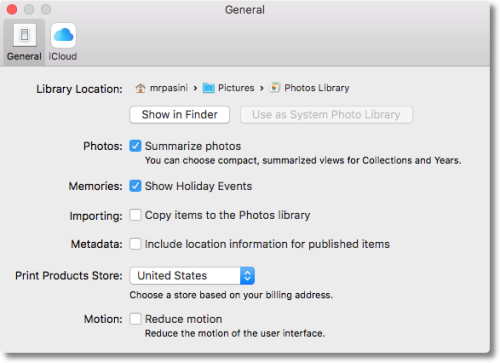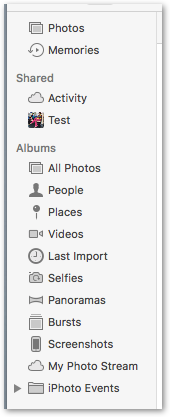C O N T E N T S
•
•
Photo Corners headlinesarchivemikepasini.com
![]()
A S C R A P B O O K O F S O L U T I O N S F O R T H E P H O T O G R A P H E R
![]()
Enhancing the enjoyment of taking pictures with news that matters, features that entertain and images that delight. Published frequently.
An Apple Photos Project




27 April 2017
Ah, the right tool for the right job. That's always the trick, isn't it? That's what we were thinking at Mom's the other day when we helped set up her new iMac.

Mom & the New iMac. The past within arm's reach.
We have, over the years, silently bemoaned that the two generations of tools in the basement at her house never seem to contain the one tool in our basement 12 miles away that would do some simple repair job properly. We wish we had a 12-mile-long arm we could just stretch out to get what we needed.
Software, fortunately, is not so constrained.
Her old iMac (an original white plastic Intel box over 10 years old and still kicking) had over 10 years of photos on it, each in their own folder in the Pictures folder. That scheme was improvement, if only slightly, over leaving them on the Desktop.
But that arrangement, we realized, as we copied them over, was like consigning them to a shoebox stored in the attic where her walker couldn't ever take her.
How could she (and Siri) mine those old and pleasant memories?
Apple Photos, included at no extra charge with every new Macintosh. That's how.
OPTIONS
Apple Photos has been bashed for not having the professional demeanor, you might call it, of Aperture, instead resembling the family picnic behavior of iPhotos. Photographers who like to organize their images by shoot and session have preferred migrating to applications like Capture One Pro and Lightroom.
But there's a lot to be said for Apple Photos.
There's also a lot to be said to Google Photos, we must quickly add, especially because it alone offers unlimited free on-line storage with automatic uploads from your phone. It's very rewarding to see what Google's assistants can do with your images once they are uploaded, too. It's a great solution for multiple devices and sharing. But a little too much for this job.
SIMPLE NEED
Our need in this case was simple. We just wanted a way for Mom to be able to look through the old photos stored on her new machine.
She didn't have any smartphone photos on iCloud, just the images she'd saved from various emails and events we'd copied to her old computer. So everything was local.
It was really just a matter of being able to access that local treasure as if it were memories and not files in directories that are difficult to navigate when you don't see very well any more.
Apple does provide a thorough tutorial to the desktop app in addition to specific versions for other devices and iCloud storage.
But here we'll just report our experience making these files come alive again. Not the ins and outs but just the ins.
IMPORTING
The first trick is to tell Photos about your images. You do that by importing them.
This step -- whatever the organizing software you choose to use -- seems to most confuse people. That's because you have an option.

Importing Preference. Uncheck to leave images where they already are.
You can choose to copy the image file itself into the application's catalog or database location or just leave it where it is and simply let the catalog know where it can be found.
Leaving it rather than copying it makes sense if it is always accessible. In our case, the images were all on the new hard disk. So there was no need to make a second local copy.
On the other hand, copying them would protect them should some nefarious niece or nephew reorganize the folders in her Pictures directory. And that's the default behavior. So, with a 1-TB disk, we went with that option.
We selected the folder of images to import, were shown the images for review, clicked to import and saw them come in as thumbnails. Be patient, they don't fly in all at once.
It really didn't take very long at all, though.
ORGANIZING
Once the images are in Photos, the fun begins.
Photos can instantly rearrange your view of the photo collection, automatically mining data from the Exif header and recognizing faces to make more meaningful presentations.
Some tricks aren't available immediately but a few are.
Once our files were imported they could immediately be seen arranged in groups by date when we selected the
Photosoption in the left-hand sidebar or all at once in a light table layout when we selected theAll Photosoption underAlbums.
Organizing. Instantly rearrange your view of your photos.
Those aren't bad options but Photos can do even more with its
MemoriesandPeopleoptions (among others). Those are the two that Mom found most interesting.The imported images, most of which had come from digital cameras, almost all had dates in their Exif headers, of course. But that was it.
That's how Photos knows when the photo was taken and how it can organize the images by date of creation. You can scroll through your collection chronologically and even play slide shows of any particular day's photos.
And that works well enough, although it's hard to jump around. You really just scroll through the days. Fortunately Photos has different ways to view your images.
One way to arrange your images is by using the
Memoriesoption on the sidebar. Memories are simply collections of images based, again, on the Exif header information of the photos included in the set. When you click on theMemoriesoption in the sidebar, you are presented with large title images you can click to enter each memory.But in addition to photos, Memories are titled and can also show crops of the faces of the people in those photos and locate the photos on a map with the appropriate GPS data, which most smartphones capture. Photos mines a bit more information from the image than just what it looks like.
With all that information, Memories can make it easy to find and view events, trips, locations, and people. You can scroll down through the collection or press the
Playbutton to start a slide show.While Photos will build Memories automatically, you can also manually add images to a memory by clicking on the title, scrolling to the bottom and clicking on the blue text
Add to Memories.
Slide Show. Pick a theme and the music to go with it when you hit the 'Play' button.
One of the most interesting alternate views is
People. It takes a little work to set up but even when you just get started it can be rewarding.When you click on
Peoplein the sidebar, Photos displays a few faces. You can add more with the+button. All you have to do is name them.If two of them are the same person, you can just merge the second one. There's an option on the popup menu to let you do that.
You'll spend a little time identifying people but it's worth it. It was as if the new iMac knew all about the family after just 15 minutes of identifying photos.
And when you do finally get all the images tagged, a slide show can show you someone grow up right before your eyes on the monitor.
SLIDE SHOW
However you organize your images -- or, better put, however you choose to juggle them -- the fun is seeing them presented in an automated slide show with musical accompaniment.
Photos makes that as simple as clicking the
Playbutton. That's usually easily found but is hidden in the Date view until you mouse into the date area.The shows are surprisingly sophisticated with elaborate transitions, interesting layouts that somehow seem to know who's in each image and more. And they take no work at all. Just a click.
CONCLUSION
The old iMac had all these images on its hard drive, saved from emails and copied from CDs. But they were, for the most part, inaccessible.
With Apple's free Photos and a little elbow grease, the new iMac brings them all as close as a click again with several impressive ways to enjoy them. That's called four photo corner performance around here.
So how did Mom like it?
"You were all young once," she said after looking at them a while. It was almost as if she had herself suddenly become younger looking at the old photos -- and was disappointed to see us all grow up.
But there's no tool we know of to do anything about that.